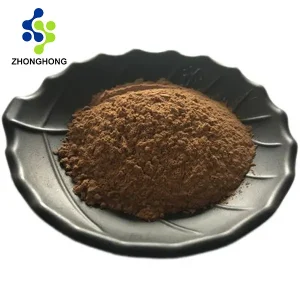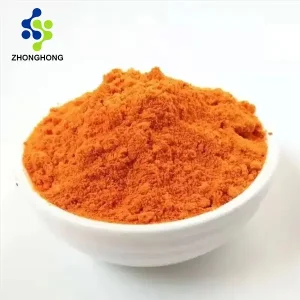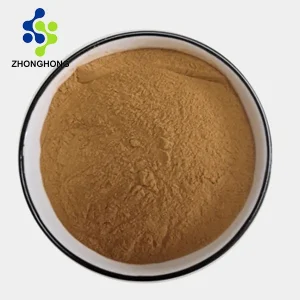Berberine Hydrochloride Powder: Ultimate Guide by Zhonghong BioTech
1. What is Berberine Hydrochloride?
Berberine Hydrochloride is the stabilized, bioavailable salt form of berberine, a potent isoquinoline alkaloid naturally occurring in plants like Berberis vulgaris (Barberry), Coptis chinensis (Goldthread), and Hydrastis canadensis (Goldenseal). This bright yellow crystalline powder is renowned for its broad-spectrum physiological activities, primarily targeting metabolic pathways via AMPK activation.
2. Source, Chemical Properties & Identification
-
Source: Extracted from plant rhizomes/roots (e.g., Coptis, Phellodendron). Zhonghong uses sustainably sourced, premium-grade Coptis chinensis.
-
Chemical Properties:
-
CAS: 633-65-8
-
Molecular Formula (MF): C₂₀H₁₈ClNO₄
-
Molecular Weight (MW): 371.81 g/mol
-
EINECS: 211-195-9
-
Appearance: Bright Yellow to Orange-Yellow Crystalline Powder
-
Solubility: Soluble in water, slightly soluble in ethanol, insoluble in non-polar solvents.
-
Melting Point: 200-203°C (decomposition)
-
Optical Rotation: -120° to -140° (c=2 in H₂O)
-
3. Premium Berberine HCl: Key Attributes (Zhonghong BioTech Standard)
Zhonghong BioTech sets the benchmark for pharmaceutical-grade Berberine HCl:
-
Composition: ≥98% Berberine Hydrochloride (HPLC), minimizing minor alkaloids (e.g., jatrorrhizine, palmatine).
-
Efficacy (Compliance): Manufactured under cGMP, compliant with USP/EP monographs. Validated for key bioactivities:
-
Metabolic Health: AMPK activation supporting healthy glucose uptake & lipid metabolism (PMID: 25607236).
-
Microbiome Modulation: Selective inhibition of pathogenic gut bacteria; promotes beneficial species.
-
Cardiovascular Support: Modulates LDL-receptor expression & endothelial function.
-
Cellular Health: Exhibits antioxidant and potential autophagy-enhancing properties.
-
-
Origin: Sourced & fully manufactured (extraction to micronization) in China, ISO 9001/22000 certified facilities.
-
Usage: Typical dose range: 500mg-1500mg daily, divided (e.g., 500mg TID). Formulated in capsules, tablets, or functional foods. Consult a healthcare provider.
-
Target Audience: Adults seeking metabolic/cardiovascular support. Not for children.
-
Crucial Precautions & Side Effects:
-
Contraindications: Pregnancy, lactation. Potent CYP3A4/P-gp inhibitor – avoid with cyclosporine, tacrolimus, simvastatin, many antibiotics. Consult physician if taking any medication.
-
Side Effects: Generally mild (dose-dependent): GI discomfort (constipation, cramping), rare potential for hypoglycemia.
-
Max Intake: Do not exceed 2000mg/day without medical supervision. Start low dose.
-
Testing: Recommend liver/kidney function monitoring with long-term, high-dose use.
-
4. Zhonghong BioTech: Pioneering Plant Actives Since 1996
Shaanxi Zhonghong Investment Technology Co., Ltd. is a vertically integrated leader in high-purity botanical extracts and bioactive compounds. We serve global innovators in nutraceuticals, pharmaceuticals, cosmeceuticals, and functional foods.
-
Scientific Edge: 5 University Joint Labs (e.g., CAS Institutes), 20+ Patents (e.g., Novel Purification, Polymorph Control), exclusive 10,000+ compound library.
-
Analytical Leadership: State-of-the-art QC: UHPLC-DAD-ELSD, GC-MS, ICP-MS, NMR. Purity standards exceed USP by ≥20% (typically ≥98.5% Berberine HCl).
-
Global Reach: cGMP-compliant supply to 80+ countries, offering bespoke solutions for Tier-1 Pharma and research institutions.
5. Health Benefits & Mechanisms
-
Glucose Homeostasis: Activates AMPK, enhances insulin sensitivity, inhibits hepatic gluconeogenesis (glucose-6-phosphatase), mimics insulin action.
-
Lipid Regulation: Upregulates hepatic LDLR expression, modulates PCSK9, activates AMPK→ACC inhibition.
-
Gut Health: Disrupts bacterial biofilm formation, inhibits virulence factors (e.g., E. coli LT/ST toxins), fosters Akkermansia/Bifidobacterium growth.
-
Cardioprotection: Improves endothelial NO synthesis, reduces LOX-1 expression, attenuates ox-LDL uptake.
-
Cellular Resilience: Modulates Nrf2/KEAP1 pathway, enhances endogenous antioxidants (SOD, GSH); potential mTOR inhibition influencing autophagy.
6. Usage Guidelines
-
Standard Dose: 500mg taken 2-3 times daily before meals. Bioavailability enhancers (e.g., liposomal, with piperine) may allow lower doses.
-
Formulation: Ideal for solid dosage forms (tablets, capsules). Ensure compatibility with excipients (hygroscopic).
-
Synergists: Often combined with Silymarin (liver support), Chromium Picolinate, or Alpha-Lipoic Acid.
7. Critical Precautions
-
Drug Interactions: STRONG CYP3A4/P-glycoprotein inhibition. Contraindicated with immunosuppressants, statins, most macrolides/fluoroquinolones, antifungals, SSRIs, Ca²⁺ channel blockers, sedatives. Mandatory HCP consultation if medicated.
-
Medical Conditions: Avoid in hypotension, bradycardia, renal/hepatic impairment. Monitor blood glucose closely in diabetics.
-
Duration: Limited long-term human safety data. Consider cycling (e.g., 8 weeks on, 2-4 weeks off).
8. Product Specification & Certificate of Analysis (COA)
| Parameter Category | Test Item | Specification | Test Method |
|---|---|---|---|
| Pesticide Residues | Chlorpyrifos | ≤ 0.01 ppm | GC-MS/MS (EU 396/2005) |
| Cypermethrin | ≤ 0.05 ppm | GC-MS/MS (EU 396/2005) | |
| Total DDTs | ≤ 0.05 ppm | GC-MS/MS (EU 396/2005) | |
| Total BHCs | ≤ 0.05 ppm | GC-MS/MS (EU 396/2005) | |
| Heavy Metals | Lead (Pb) | ≤ 1.0 mg/kg | ICP-MS (USP <232>/<233>) |
| Arsenic (As) | ≤ 1.0 mg/kg | ICP-MS (USP <232>/<233>) | |
| Cadmium (Cd) | ≤ 0.5 mg/kg | ICP-MS (USP <232>/<233>) | |
| Mercury (Hg) | ≤ 0.1 mg/kg | ICP-MS/CVAAS (USP <232>/<233>) | |
| Microbiological | Total Aerobic Count | ≤ 1000 CFU/g | USP <61> |
| Yeast & Mold | ≤ 100 CFU/g | USP <61> | |
| E. coli | Absent in 1g | USP <62> | |
| Salmonella spp. | Absent in 10g | USP <62> | |
| Staph. aureus | Absent in 1g | USP <62> | |
| Assay (HPLC) | Berberine Hydrochloride | ≥ 98.0% | USP Chromatographic |
9. Advanced Production Flow
-
Raw Material QC: Species authentication (HPTLC, DNA barcoding), heavy metal/pesticide screening.
-
Extraction: Optimized acidified ethanol percolation (pH 2-3, 60°C).
-
Macroporous Resin Purification: Selective adsorption/desorption to remove polysaccharides, pigments.
-
Crystallization: pH-controlled anti-solvent crystallization (Ethanol/H₂O system) for defined particle size distribution.
-
Recrystallization: High-purity solvent system for final polymorph control (Anhydrous form).
-
Micronization: Jet milling to target D90 < 45µm for optimal dissolution.
-
Strict QC: In-process checks & final release per COA specs. Stability studies (ICH Q1A).
10. Application Scenarios
-
Nutraceuticals: Metabolic health capsules, blood sugar support blends, weight management formulas.
-
Pharmaceuticals: API for anti-diabetic, anti-dyslipidemia, or antimicrobial formulations (research stage).
-
Functional Foods/Beverages: Fortified powders, health drinks (requires taste-masking).
-
Cosmeceuticals: Acne topical treatments (antibacterial/anti-inflammatory), anti-aging serums.
-
Research: Molecular biology (AMPK pathway studies), microbiology (antimicrobial mechanisms).
11. Stringent Quality Control
Zhonghong employs a multi-tiered QC strategy: Identity (FTIR, NMR fingerprinting), Assay (Validated RP-UHPLC with DAD/ELSD detection), Related Substances (HPLC for jatrorrhizine, palmatine <1.0%), Residual Solvents (GC-MS per ICH Q3C), Heavy Metals (ICP-MS), Microbiology (rapid methods & compendial), Particle Size (Laser diffraction), XRD (Polymorph verification). Our stability program (25°C/60% RH, 40°C/75% RH) ensures 36-month shelf life in alu-foil bags. Batch traceability is paramount.
12. Packaging & Logistics
-
Primary: Double HDPE bags with food-grade PE liner. Optional vacuum packing.
-
Secondary: Sealed in moisture-proof, light-resistant fiber drums (25kg net).
-
Logistics: Ambient shipping globally. MSDS, Certificate of Origin, Full COA provided. DDP/DAP terms available. Fast EU/US warehouse dispatch.
13. Research & Innovation
-
Health Mechanisms: Ongoing research explores NLRP3 inflammasome modulation, gut-brain axis impact, and mitochondrial biogenesis effects.
-
Tech Innovation: Zhonghong focuses on:
-
Enhanced Bioavailability: Novel nanoemulsions, phospholipid complexes.
-
Synthetic Biology: Engineered microbial biosynthesis of berberine precursors.
-
Derivatization: Novel berberine salts/esters for improved solubility/targeting.
-
-
Challenges: Overcoming low oral bioavailability (~<5%), managing DDIs, establishing definitive long-term clinical outcomes.
14. Frequently Asked Questions (FAQ)
-
Q: Is Berberine HCl better than Berberine Sulfate? A: HCl generally offers higher solubility and bioavailability than sulfate salts.
-
Q: Can I take Berberine HCl long-term? A: While generally safe for periods of 3-6 months in studies, discuss long-term use and cycling with your healthcare provider. Monitor liver/kidney function.
-
Q: Does it cause weight loss? A: It supports metabolic health and may aid weight management as part of a healthy lifestyle, primarily through AMPK effects on metabolism.
-
Q: How long to see benefits? A: Metabolic effects (glucose/lipids) often observed within 4-8 weeks.
-
Q: Is Zhonghong’s Berberine non-GMO & Allergen-Free? A: Yes, certified non-GMO, gluten-free, soy-free, dairy-free. Kosher/Halal available.
-
Q: Can I get a sample? A: Yes! Request below.
15. Sourcing & Samples
Source Premium Berberine Hydrochloride Powder:
-
Website: https://www.aiherba.com
-
Contact: Mr. Liao DaoHai
-
Email: liaodaohai@gmail.com
-
Request: Inquire for bulk pricing, technical dossier (TDS, CoA, MSDS), and FREE 20g SAMPLES (qualifying B2B clients).
Conclusion
Berberine Hydrochloride Powder represents a powerful tool in metabolic health support. Choosing a supplier with uncompromising quality, scientific rigor, and regulatory expertise like Zhonghong BioTech is critical for product efficacy and safety. Our vertically controlled process, from validated botanical sourcing to cutting-edge purification and QC, delivers berberine HCl of exceptional purity (>98%) and consistent biological activity. Contact us today to elevate your formulations.
References (Illustrative)
-
Imenshahidi M, Hosseinzadeh H. Berberine and barberry (Berberis vulgaris): A clinical review. Phytother Res. 2019.
-
Pang B, et al. Application of berberine on treating type 2 diabetes mellitus. Int J Endocrinol. 2015.
-
Koppen LM, et al. Efficacy of berberine in cardiovascular disease risk reduction. Nutr Metab Cardiovasc Dis. 2020.
-
ICH Q7: Good Manufacturing Practice Guide for Active Pharmaceutical Ingredients.
-
USP-NF Monograph: Berberine Hydrochloride. (Accessed July 2025).






评价
There are no reviews yet.